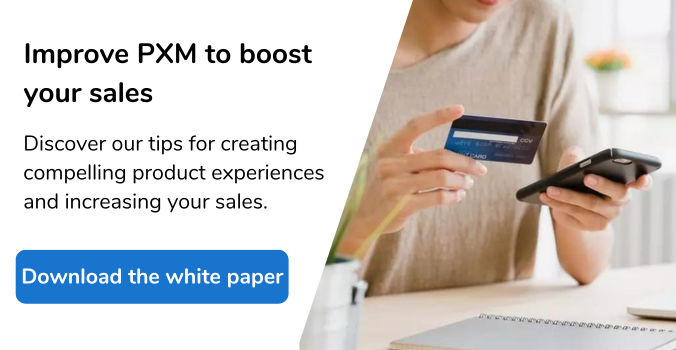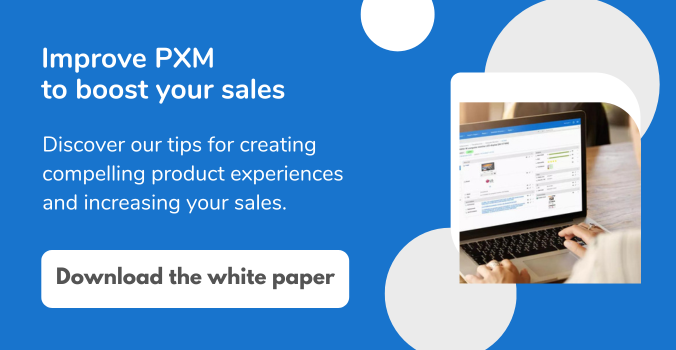It is essential to optimize product discoverability on your eCommerce site to enhance the user experience.
When a shopper visits an eCommerce site, they want to quickly find the product they're looking for and they expect brands to provide advanced search features: over 30% of shoppers1 use the search bar and 20%2 are frustrated if there are no filters to help them refine their search.
To assist them in their search for a given product, businesses must present a structured product catalog and provide an optimal search experience: faceted search, internal search engine, autocomplete features, searchandising… This is essential to meet the demands of shoppers with 83% of them3 not being fully satisfied with the search experiences generally available on eCommerce websites.
Discover the 5 tips for improving product search on your eCommerce site.
#1. Work on product categorization
On an eCommerce site, shoppers want to access the full range of a brand's product offer and a majority of these shoppers (54%2) browse through the main menu to discover product categories.

To optimize their browsing experience, it is essential to categorize your products using short and simple category names to make it easy for shoppers to identify the content of each category.
You also need to organize these categories strategically in the main menu and use A/B testing4 to find the layout that generates the most conversions. For example, IKKS created a specific category to present its “i-code” clothing collection. For this category the A/B tests identified the best position in the main menu resulting in a 16.5%4 increase in the click rate.
#2. Implement faceted search
When a shopper visits an eCommerce site, they expect an optimal search experience and if they are not satisfied with this experience 68% of them1 will not return to the website in question.
To meet this expectation, you should implement faceted search which is a browsing method enabling shoppers to refine their search criteria (size, color, price range…), reduce the depth of a catalog and easily5 find a product corresponding to their needs.
Faceted search also tends to increase conversions. One example is the Rollie Nation shoe brand which implemented this browsing method on their eCommerce site and saw their sales increase by 2.7%5 as a result. With faceted search, shoppers can filter the brand's shoes according to different options5 (style, size, price, colors…) and quickly find the product that matches their search criteria.
#3. Optimize your internal search engine
On an eCommerce site, 50% of shoppers6 use the search bar to find a specific product, with queries tending to be quite specific: 81% of them7 contain more than two words.
To adapt to these search habits, you must provide shoppers with a robust internal search engine including autocompletion features which predict the shopper's query to reduce the need for typing in the search bar. This feature greatly speeds of the product search effort.
The internal search engine must also have a “synonym management” feature which allows the system to identify a wide range of keywords (synonyms, abbreviations, acronyms…) and enables the shopper to access pages that are relevant to their search intentions.
These features improve the results of your eCommerce site, increasing the conversion rate by up to 2%8 and reducing the risk of errors in the queries made by 50%8.
#4. Use searchandising
The search bar is a crucial element of any sales strategy with shoppers using it being three to six times9 more likely to buy than those simply browsing the site.
To transform an eCommerce site's search bar into a sales opportunity, you should use “searchandising” which involves optimizing the internal search engine to increase conversions and sales.
For example, when an internal search engine sorts the results of a user query, it must consider the sales criteria10 when sorting: product rotation, profit margin, available stocks… It is important to consider these criteria so as to show the most profitable products. Special offers and banners11 can also be displayed within the search results and contribute to creating new sales opportunities.
#5. Adapt the search function to mobile phones

67% of shoppers12 use their smartphones when shopping. This makes them increasingly demanding when using the mobile version of an eCommerce site. 85% of shoppers13 consider that the mobile version should be equivalent or better than the desktop version.
These expectations make it necessary to provide a mobile first14 search experience for shoppers. On the mobile version of an eCommerce site, the search bar should be immediately identifiable and take up most of the width of the screen to ensure ultimate browsing comfort. It is also important that the page loads quickly: 53% of website15 visits on mobile phones are abandoned if the page takes over 3 seconds to load.
To sum up, the product search element of an eCommerce site is essential and requires constant improvement: implementation of faceted search, optimization of the internal search engine, use of searchandising… These efforts are essential to help shoppers find their ideal product and to quickly achieve their shopping goals.
1
Charlton, G. C. (2021, October 11). 28 Ecommerce Site Search Best Practices. salecycle.com.
2
Sensefuel. (2019). L'observatoire des pratiques de recherche dans l'e-commerce.
3
Henry, B. H. (2021, February 23). Observatoire des pratiques de recherche dans l'e-commerce, édition 2021.
4
Ouanes, S. O. (2017, May 16). 10 astuces UX pour créer un menu de navigation optimal. kameleoon.com.
5
Bhattacharya, J. B. (2018, October 5). 11 Great Examples of Ecommerce Navigation That Can Improve Sales. semrush.com.
6
Vendramini, S. V. (2020, September 18). Comment le search permet de doper ses ventes en ligne. journaldunet.com.
7
Marius, S. M. (2019, February 20). Infographie Les moteurs de recherche internes des sites e-commerce doivent progresser. ecommercemag.fr.
8
Lewis, P. H. (2020, January 7). E-commerce site search best practices. accenture.com
9
Guillard, S. G. (2017, July 6). Le moteur de recherche interne est un accélérateur de performances pour les e-commerçants. ecommercemag.fr.
10
Muraccioli, M. M. (2018, April 4). Comment augmenter ses ventes e-commerce grâce au searchandising ? journaldunet.com.
11
Muraccioli, M. M. (2018, May 31). Le lexique du moteur de recherche e-commerce personnalisé. emarketerz.fr.
12
Ouellette, C. O. (2022, January 7). Online Shopping Statistics You Need to Know in 2022. optinmonster.com.
13
A., J. A. (2021, March 10). Essential UX Statistics — Everything You Need to Know. smallbizgenius.net.
14
Assouline, R. A. (2015, May 20). Mobile First : une nouvelle façon de concevoir un projet digital. journaldunet.com.
15
Bush, M. B. (2018, April). Chaque seconde, chaque étape et chaque utilisateur méritent votre attention. thinkwithgoogle.com.







